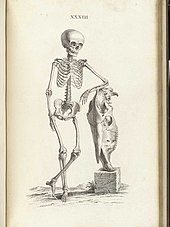William Cheselden
William Cheselden (born October 19, 1688 in Somerby near Burrough on the Hill, Leicestershire , † April 10, 1752 in Bath, Somerset) was an English surgeon and anatomist who played a major role in the establishment of surgery as a medical science.
Life
Cheselden studied from 1703 anatomy in London under William Cowper (1666-1709) and lectured in anatomy from 1710. 1713 he published his work Anatomy of the Human Body (German: Anatomy of the human body ), the great popularity learned in 13 editions appeared. The main reason for the dissemination of the work was that - in contrast to the then common Latin - it appeared in English. In 1718 he was appointed assistant surgeon at St Thomas' Hospital in London. The following year he became a surgeon and, as such, was appointed to the newly built St George's Hospital in 1734. In 1710 he was accepted into the London guild of Baders and elected as a scientist in the Royal Society in 1712 . In 1729 he became a corresponding member of the Académie des sciences .
In 1733 he published Osteographia or the Anatomy of Bones (German: Osteologie or the anatomy of bones ), the first complete and correct description of the anatomy of the human skeleton.
Cheselden said goodbye to St Thomas in 1738 and went to the Royal Hospital Chelsea . In 1744 he was elected to the board of directors of the Bader's Guild and played a major role in separating the hairdressers from the surgeons and founding his own society of surgeons in 1745. The organization later became the major Royal College of Surgeons of England .
He died in Bath, Somerset, in 1752.
plant
Cheselden is famous for inventing the lateral bladder stone incision ( lithotomy ) method to remove bladder stones . He carried out this procedure, which was characterized by its short duration (minutes instead of hours) and low mortality (less than 10%), for the first time in 1727. Cheselden had already developed the suprapubic procedure in 1723 , which he published as A Treatise on the High Operation for the Stone .
He made equally important contributions to eye surgery with the iridectomy he developed , which he first described in 1728. With it, certain forms of blindness can be treated by creating an artificial pupil . Cheselden was the first to describe the role of salivary flow in digestion .
He visited Isaac Newton when he was last ill and was a good friend of Alexander Pope and Sir Hans Sloane .
Fonts
Translations
- W. Cheselden's anatomy of the human body: With forty copper plates after Vandergucht von Riepenhausen . Translated from English by August Ferdinand Wolff with a preface by J. Fr. Blumenbach. Dieterich, Göttingen 1790 digitized
literature
- RH Nichols, FA Wray: The History of the Foundling Hospital. Oxford University Press, London 1935, p. 353.
- Barbara I. Tshisuaka: Cheselden, William. In: Werner E. Gerabek , Bernhard D. Haage, Gundolf Keil , Wolfgang Wegner (eds.): Enzyklopädie Medizingeschichte. de Gruyter, Berlin / New York 2005, ISBN 3-11-015714-4 , p. 241 f.
- Cheselden, William . In: Encyclopædia Britannica . 11th edition. tape 6 : Châtelet - Constantine . London 1910, p. 89 (English, full text [ Wikisource ]).
Web links
- William Cheselden (1666–1709), Surgical Tutor ( Memento from May 28, 2014 in the Internet Archive )
- Cheselden, Wm: Osteographia or the Anatomy of the Bones. Scanned pages of his original work. Historical anatomy on the web. US National Library of Medicine.
- Entry to Cheselden; William (1688–1752) in the Archives of the Royal Society , London
Individual evidence
- ^ List of members since 1666: Letter C. Académie des sciences, accessed on October 29, 2019 (French).
| personal data | |
|---|---|
| SURNAME | Cheselden, William |
| BRIEF DESCRIPTION | English surgeon, urologist and anatomist |
| DATE OF BIRTH | October 19, 1688 |
| PLACE OF BIRTH | Somerby, Leicestershire |
| DATE OF DEATH | April 10, 1752 |
| Place of death | Bath, Somerset |

